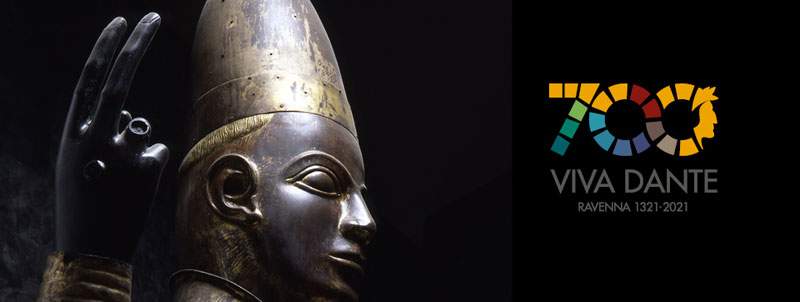On the occasion of the seven hundredth anniversary of Dante ’s death, the exhibition Le Arti al tempo dell’esilio (The Arts at the Time of Exile ), the second major event in the exhibition cycle Dante. The Eyes and the Mind, promoted by the Municipality of Ravenna - Department of Culture - MAR Art Museum of the City of Ravenna, curated by Massimo Medica. The exhibition is scheduled to run from March 6 to July 4, 2021 and is also made possible thanks to the Uffizi Galleries, for a multi-year collaboration agreement that ideally sanctions the twinning between the city where the poet was born and the one where he died and rests.
According to what has been announced, it will be an exhibition of authentic masterpieces, quantitatively concentrated, essential and precise: the curatorial choice has been to bring together only testimonies of absolute exception and strictly adherent to the theme, that is, emblematic of the stages of Dante’s exile, and to propose what Dante had the opportunity to admire in his long wanderings through Italy.
The exhibition will kick off with the powerful gilded bronze effigy of Boniface VIII, the one who condemned the poet to exile. Alongside this will also be a cast of a portrait of Boniface himself by Arnolfo di Cambio, now in the Vatican Palaces. The Florentine environment will be documented in the exhibition by works by Cimabue and Giotto, dated to Dante’s time in Florence and which he most likely had the opportunity to admire.
Forced to leave Rome as well, Dante traveled the long road of exile that took him to several cities, including Arezzo, Verona, Padua, Bologna, Lucca, Pisa and Ravenna.
The innovations in art and the profound changes that took place in that sphere during the years of exile will be witnessed in paintings, sculptures, illuminated manuscripts, and goldsmithing.
The Roman months are evoked by Jacopo Torriti’s portraits of St. Peter and St. Paul at the time of Dante in the portico of St. Peter’s. Dante was then welcomed to the Forli of the Ordelaffi family and to Verona, where he came under the protection of the Scaligeri family first in 1303-1304 and then in 1313-1318. Precious textiles, goldwork, painted panels, and sculpture (the latter by the Master of St. Anastasia) documented the poet’s stay at the Venetian court. Around 1304 he was in Padua: these were the years in which Giotto was completing the decoration of the Scrovegni Chapel, and among the first to transpose Giotto’s innovations were the Paduan masters of the miniature. Thus, for the first time, the very precious Offiziolo, now privately owned, which belonged to the poet Francesco da Barberino, a friend of Dante’s, will be on display. The art of miniature also fascinated Dante in his next stop in Bologna: in the eleventh canto of Paradise, the poet mentions one of the masters of the Bolognese school of this art, Franco Bolognese. In this section, one of the absolute masterpieces of the art of illumination is the historiated Bible that belonged to Charles V, exceptionally granted by the Library of the Monastery of the Escorial.
After sojourns in the Marca Trevigiana and then in the Lunigiana of the Malaspina family, Dante moved to Casentino, then to Lucca, where he had the opportunity to admire the works of Nicola Pisano for the cathedral (present in the exhibition is the cast of the lunette with the Deposition from the Cross, preserved in Pisa in the Museo di San Matteo) and again to Forlì in 1310. It was here that he probably learned the news of the descent into Italy of the new emperor Arrigo VII, toward whom he focused his hopes and dream of imperial restoration. A dream shattered by the death of the sovereign, whose funeral, in Pisa Cathedral, was probably also attended by Dante, who thus had the opportunity to admire some of the absolute masterpieces created by Nicola and Giovanni Pisano. Also on display is the effigy of Justice, commissioned for the tomb of Margaret of Brabant, the emperor’s wife. Evidence by Nicola and Giovanni Pisano will flank that of Arnolfo di Cambio, from the National Gallery of Umbria.
Dante arrived in Ravenna around 1319, while Giovanni and Giuliano da Rimini were working in the city: the latter was commissioned to decorate the chapel of the church of San Domenico, also followed by Pietro da Rimini. To the masterpieces of these two artists the exhibition reserves ample space in its concluding section, along with testimonies related to Venetian figurative culture, documenting the last diplomatic venture carried out in the Serenissima by the poet.
Closing the exhibition will be the Madonna and Child that originally protected Dante’s modest sarcophagus and that, for this occasion, thanks to a loan from the Louvre, will return to Ravenna for the first time.
For info: www.mar.ra.it
 |
| Dante 700: a major exhibition in Ravenna will celebrate the arts at the time of exile |
Warning: the translation into English of the original Italian article was created using automatic tools. We undertake to review all articles, but we do not guarantee the total absence of inaccuracies in the translation due to the program. You can find the original by clicking on the ITA button. If you find any mistake,please contact us.